https://rhythmsfitness.com/our-instructors (copyright 2002)
Ridgecrest By Keith Stanley
I was in Hong Kong in late 1998, the first stop on my (first) Asian Vacation. Basically, I kept a journal while on vacation and took pictures. After returning, I wrote this page, based on journal excerpts and the pictures.
November 17, 1998
Hong Kong reminds me of a cross between Honolulu and London. Honolulu for the “skyscrapers” along the shoreline against a backdrop of higher hills, buildings climbing the hills wherever a foothold can be found. London for its use of “proper English,” driving on the left, and for Spenser & Marks. Like Hawaii, it never gets very cold here (although there is more in the way of seasonal variation both in temperature and (I think) rainfall). It’s now the dry season, although it’s been misting a bit this evening. It’s been shirt-sleeve weather and humid. While Honolulu is predominantly American with many Oriental tourists (Japanese), HK is predominantly Oriental (Chinese) with many English speaking tourists.
My room has a great view, as billed. Yesterday evening (after dark) I got some great pictures (if they come out–these are among the first pictures I’ve ever taken at night). I went up to the roof of my hotel (Salisbury YMCA) and got a series of shots of the HK skyline across the bay. It is impressive, and so beautiful at night. Night is its time to shine! Skyscrapers and high-rises, some of impressive architectural design, go on for what seems to be miles in either direction along the far shore of Hong Kong island. Myriad twinkling lights and large solid-block-lettered internally illuminated signs in reds and blues cast colorful reflections across the water. The harbor is busy, plied by boats, some working and some sight-seeing, small shipping, occasional larger ships. One fifty story building, square cross-sectioned, ringed with neon in parallel rings that become more closely spaced as they reach the top, changes its colors in streaming patterns.
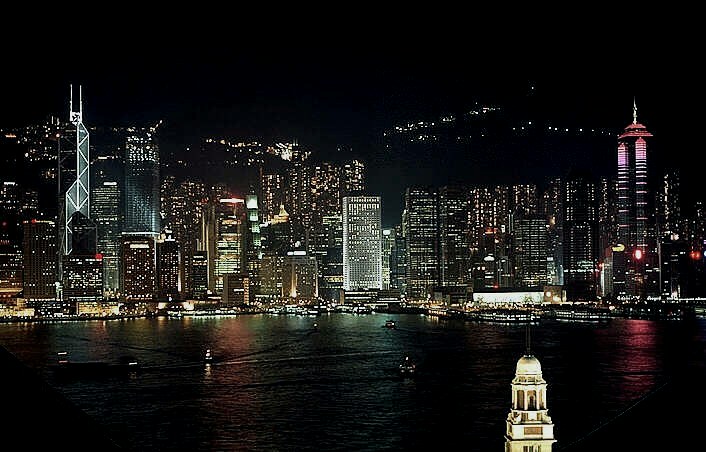
Eventually a security person came and told me to leave the roof. He was Chinese, didn’t speak (much) English, but I could tell he wanted me to leave (plus, I’d seen the “restricted access” signs on the stairway up to the roof).
I don’t know why they don’t allow free access all the time. It’s such a delightful place (and they could make it even more so with some tables and chairs). Who uses it? Seems like there would be someone, otherwise why the landscaping (all along the bay-facing edge)? Fortunately, I’d gotten all my pictures before I was shooed away.
My room is on the tenth floor, with the same view of the harbor as from the roof (but at a lower angle). Just across Salisbury Road from the hotel is the new Cultural Center, extensive, modern, esthetically lighted. The roof of the portion containing the theatre and the concert hall is convex, sweeping, and brackets some of the buildings across the bay. The Center’s promenade (2 levels) extends for what seems several blocks along the Kowloon waterfront. I take pictures from my room, one nicely framing the art museum portion of the center (which museum currently features an Egyptian exhibit).
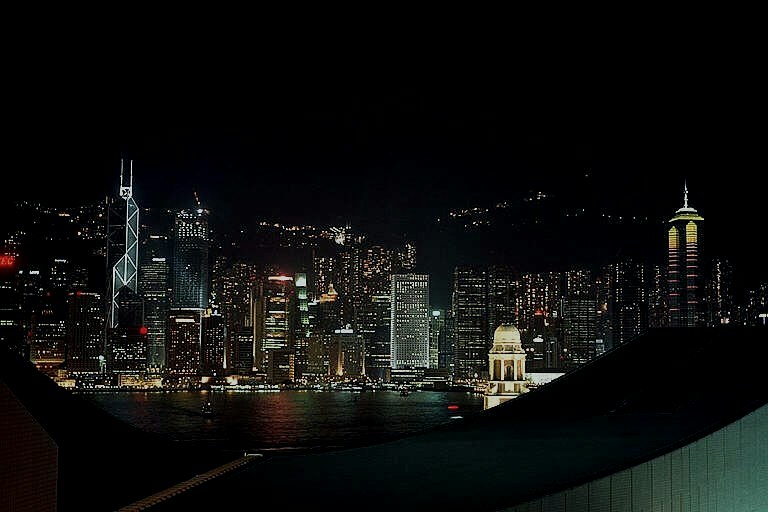
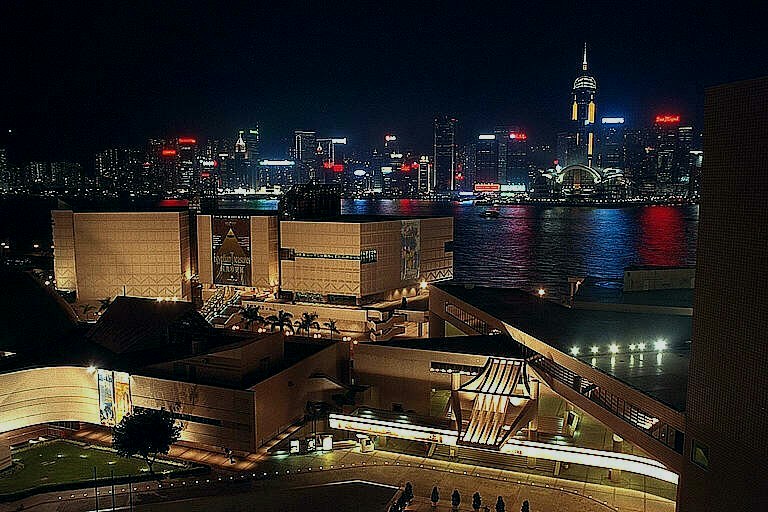
Another part of the center is the space museum, which judging by its domed portion contains a planetarium. There are several fountains and pools on the site, along with the historic clock tower. Maybe tomorrow night I’ll go back and get pictures of it all–it is, as I said, all very nicely lighted.
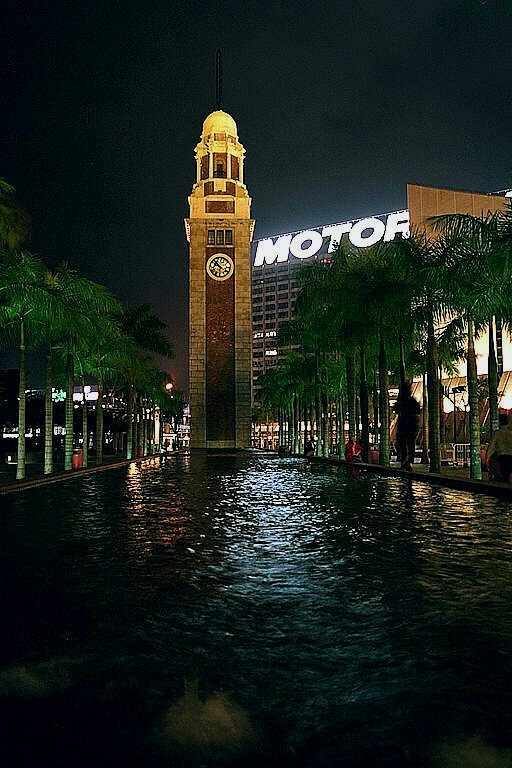
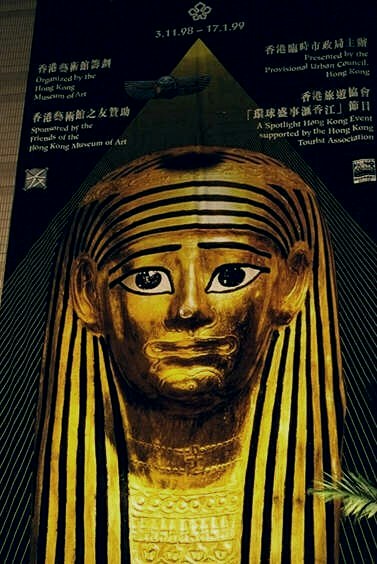
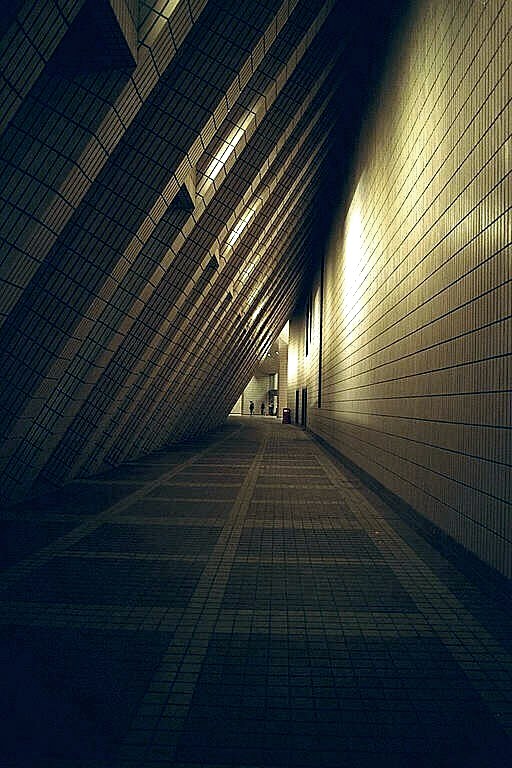
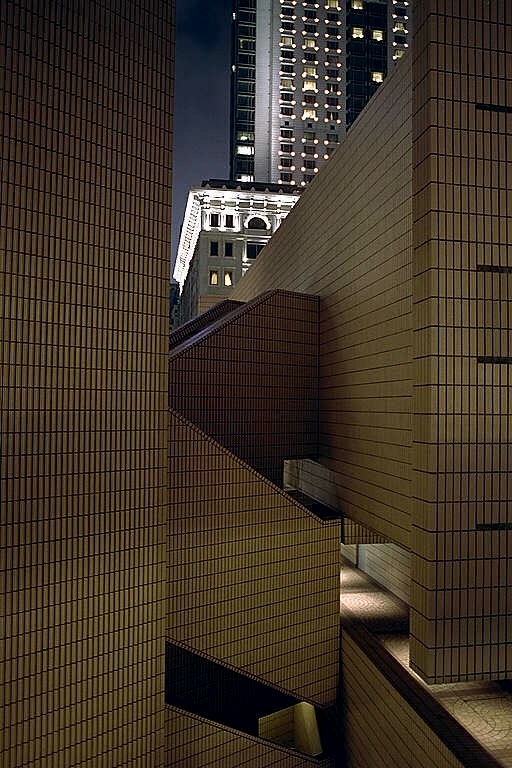
Last night I walked up Nathan Road on busy sidewalks past upscale shops, overhanging neon brandname signs, past Kowloon Park.
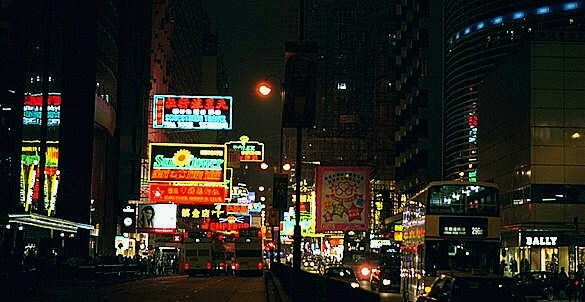
I went through the several blocks of the Temple Street night market, blocked to motor traffic, sellers’ wares in makeshift stalls, very brightly lit. The passage down the center was not very wide, only wide enough in places for three or four people abreast, which made for considerable congestion as foot traffic streamed in either direction. The goods I was most tempted to buy included knock-off designer watches (wide selections in various stalls, running perhaps $50 or $100 HK dollars (7.8 HK dollars to one U.S.)), music CD’s (pop rock anthologies by well-known performers for $30HK), and sharp-looking designer shirts (Dunhill and Versace) individually boxed for $50HK (these also were fakes, at least judging by the feel of the fabric of one of the Dunhills, which was supposed to be 100% cotton but felt like polyester). The far (northern) end of the market was permeated by a smell–at first I thought someone might have “stepped in it” but soon found that the smell (now stronger and really pretty bad) was emanating from street food vendors cooking. I didn’t know what the food was or who would want to eat it.
Spanning Temple Street and some of the other streets in that area, were colorful, even garish, neon signs, strung between the buildings, which were largely apartment buildings of maybe 8 or 10 floors each, constructed of concrete or other utilitarian material. The buildings were worn and, in my opinion, would not be esthetically pleasing, even if it weren’t for the laundry hanging on racks and lines outside many of the units.
Coming in from the new airport on the express train, I was surprised (and disappointed) at how utilitarian (and even unsightly or ugly) the first groupings of suddenly-sprouting, 20 or 30 floor, residential buildings looked. I would have imagined something more classy, and I suppose such do exist, but those like I saw are common in the parts of Kowloon I’ve so far seen.
Wednesday, November 18, 1998 (evening)
I did get more done than yesterday, but it was not all happiness and light. The weather began better than expected (it was sunny), so I decided to go across the bay to Central. By the time I got there, it had clouded over and there was an increasingly heavy haze at ground level. I found a footpath in the heart of the city, uphill, landscaped with greenery and a bit separated from the traffic, which is to say it was pretty nice. The greenery was not 100% fulsome and lush (it wasn’t the untamed wilderness), but, nonetheless, there were some esthetically pleasing vistas along the path, especially the portion of the path going through the Botanical Gardens (which Gardens also contained an extensive aviary).
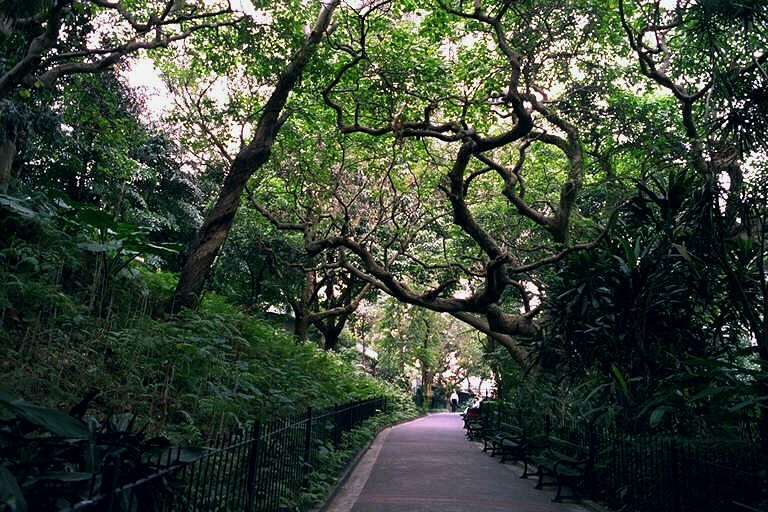
I sought out the tram (funicular railway) to The Peak (referring, I believe, to Victoria Peak, which overlooks all of Hong Kong Bay. For something as substantial as you’d expect a funicular railway to be, it was really quite difficult to find the station. I both consulted my map, and asked several people for directions, before finding it.
The ride itself was well worth it and fun. Very steep, straight up the hillside, a hillside populated with high-rises, but eventually we were higher than all of them (albeit the tops of the tallest were almost as high)! I was in the first of two cars, near the front, and so was able to see the steepness of the path lying ahead. The tram’s terminus is not actually the summit of Victoria Peak, but an upscale shopping center with a variety of eateries, including one in the futuristic looking structure of the tram terminus station itself (the upper portion of which reminded me of the bowl of a radio telescope).
The view was quite good, but the visibility quite poor (very hazy, somewhat foggy in appearance (although too breezy for there to be fog)), so I took no pictures. I may go back with good weather, and, if I do, I may try to find my way back down on foot. As it was, I took one of the public minibuses back down, which itself provided me some nice views. Most of the upper reaches of the hills are heavily wooded (I might even say forested), and have a semi-tropical feel. Trees seemed to have thick primary branches (with not much in the way of secondary branching), some reaching out over the road in a very pleasing fashion, reminding me of full-scale bonzai shaped by an unseen hand. Going by bus, I’m thinking, may be just about the best way to see parts of the island, at least if one avoids rush hour.
At The Peak shopping center, one shop had some impressive bone-carved, and even ivory, carvings in traditional style–figurines crossing rainbow bridges or on dragon boats, or sculptures of impressively sized and detailed feudalistic looking Oriental aristocracy (or so I imagined). I also was particularly taken with a substantial sized tableau of a half-dozen wild horses at full gallop, manes windswept, carved in a pale shade of jade. This was of substantial heft (although I didn’t actually lift it) and maybe 16 inches in length. It was only $10,000HK, in the same price range as were the most impressive of the bone-carved art.
I would be remiss if I didn’t say I’m somewhat disappointed in Hong Kong. It’s not quite the romantic, exotic place I saw in those travelogues I saw 30+ years ago. Where are all the junks in the Harbor, the sampans along the shore? Furthermore, I’ve yet to see the absolutely teeming crowds of people filling narrow (market?) streets, although I admit I’ve seen only a small portion of the city so far. Today I’d like to take a walking tour (self-guided) through parts of Mongkok and Yau Ma Tei.
Thursday, November 19, 1998
I just had the most marvelous shopping experience! That sounds very strange, coming from me, but it’s true! I didn’t actually buy anything; it was more a window-shopping experience. The name of the retailer is (I think) Chinese Arts and Crafts (H.K.), Ltd. Three things combine to make it amazing–(1) the wondrous variety of goods under one roof, (2) the high quality of the goods, and (3) the prices.
In some departments, it was like being in a museum of Chinese art! Certainly that was the case with many of the carvings–carvings out of semi-precious stone (jadeite, malachite, etc.), ivory, wood and other materials, much of it into traditional motiffs. Quite a goodly number of the more substantial pieces would run well into the 6 figures (the $100,000s of HK dollars). Same with the jade jewelry. I have no expertise in judging whether these are good values. However, I did see things in other departments that seemed to be pretty amazingly reasonably priced.
One area that really tempted me were the Chinese (Oriental) rugs of wool or silk. Especially intriguing to me were the 100 percent silk rugs. Silk is not a material I associate with rugs. These were more lustrous than wool and smoother to the touch. Possibly the details were more sharply defined. The pile was short. The salesman said they wear better than wool. When they need cleaning, they need dry cleaning. All the silk ones were marked down 50 percent. Some of the small ones (2’x3′) were less than $100 U.S. I’d have taken one on the spot had I seen one that would go well in my apartment.
Also they had some nice clothes. The cashmere seemed reasonable and they had padded silk women’s jackets (or were they vests?)(embroidered, I think) for maybe $40 U.S., and they felt like good quality. I thought of getting the red one (Mao style?) for K, but it wouldn’t be appropriate, so I didn’t.
Today is the day that put the H.K. portion of my trip “over the top.” What did it was the Mong Kok and Yau Ma Tei walking tour. For the first time, I saw more of the authentic, ethnic Chinese culture. I saw all kinds of street markets on narrower, more crowded streets. Food street markets, meats chopped to order, vegetables, roasted goose necks, something that looked like roasted bat, another large bowl of what looked like large (1″+) tanned maggots (grubs?) that occasionally would wiggle languorously (do people eat these & how are they prepared?)(I didn’t much cotton to the idea of popping one into my mouth raw), and other types of food (and smells) I’d not before experienced. A number of times I saw people on the street (women especially) holding cloths over their noses as if to fend off odors (but it’s not that bad).
Probably the highlight of the day (and certainly the part that brought the biggest smile to my face) was the Bird Garden in Mongkok (Yuen Po Street). Here people (mostly older men) take their birds out in cages for walks and fresh air in the company of other birds. The lane is split down the middle with the bird walkers on one side and the stalls selling birds, cages & bird food on the other side. There are birds of all sorts in very close quarters. I stopped to talk to a parrot that had seemed to address me when I looked his way and to watch a largish bird in a small cage that flitted back and forth, exchanging eye contact with me–twisting its head around, first this way, then that, to get a closer view. I found it amusing when I tried to mimic its head and eye movements. I really did have the sense we’d made some contact.
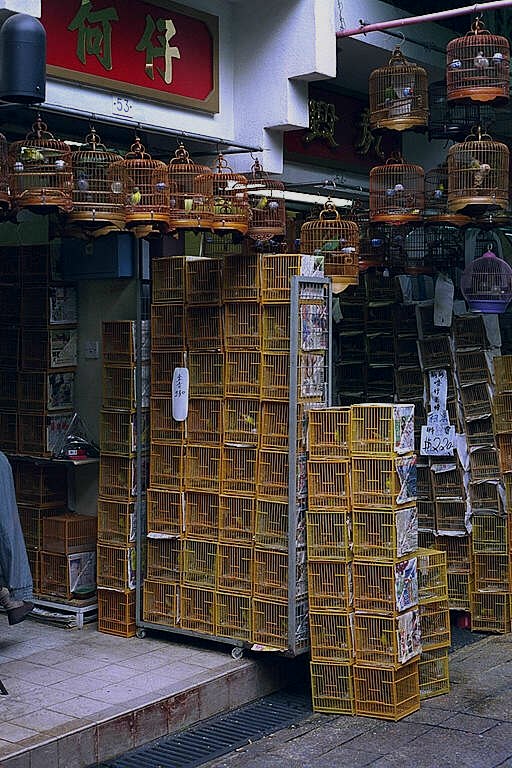
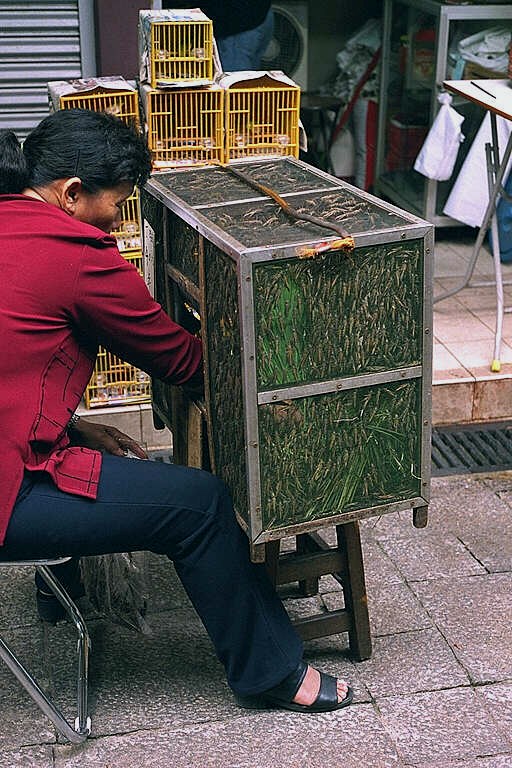
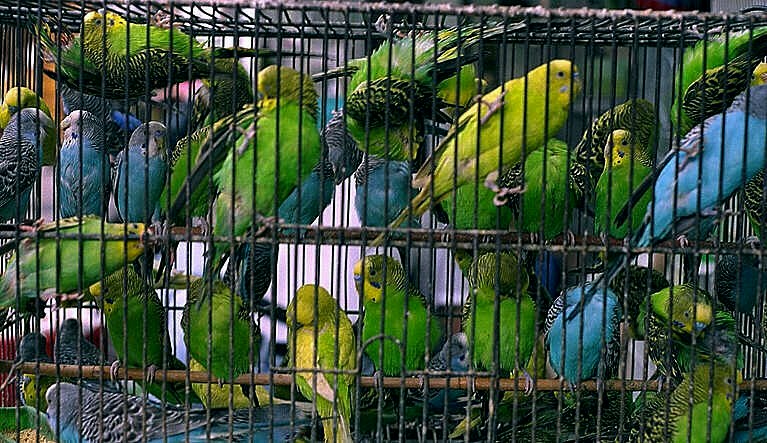
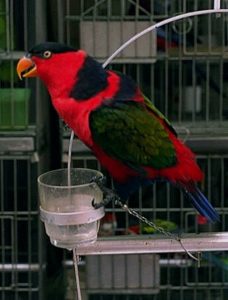
In the Yau Ma Tei neighborhood, I saw street food markets, the (covered) jade market and the Tin Hau Temple. Although both my guidebook and the HKTA recommended the temple, forget it!–I found very little there. Street food markets:
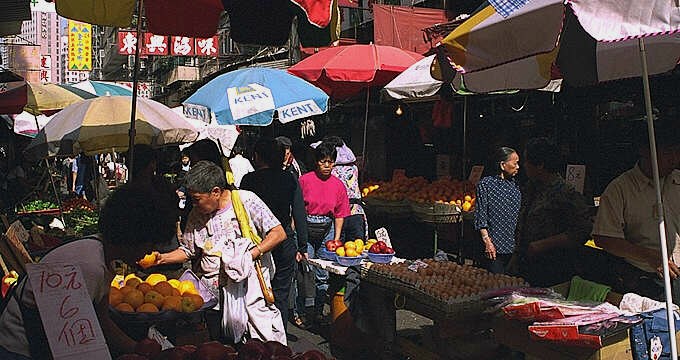
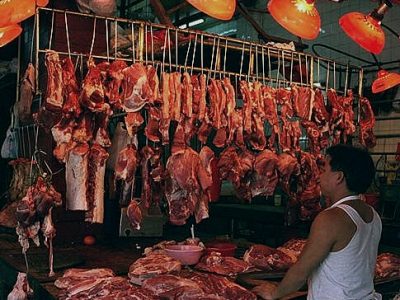
On the way back to my hotel (in Tsim Shat Tsui), I walked through Kowloon Park. It’s very nice, like a small version of Central Park in N.Y.C., surrounded by tall buildings and busy streets, but large enough to filter out traffic noise. I stopped to watch people swimming in the large indoor pool (although its been shirtsleeve weather, the outdoor pool (also very large) was closed and being repaired). The Park is really very nicely landscaped with quite a number and variety of large trees and multi-level terrain. It’s quite a nice resource for Kowloon citizens.
Friday evening, November 20:
It’s come to my last night in Hong Kong. I have enjoyed it more each day, and so it is that I am sorry to be leaving.
This morning I set out on the #6 bus from Exchange Square in Central to Stanley (on the far side (south side) of Hong Kong Island). I could not have imagined a more scenic trip. I better appreciate H.K. Island now as being essentially rocky/mountainous with settlements in shoreline areas, along with some buildings on the hillsides commanding sweeping views (often of water).
The bus was a new air-conditioned double-decker with comfortable seating and big, clean windows, the better to see the scenery. Still in the city (H.K.), we were climbing to higher and higher elevations amidst buildings perched on hillsides, admiring their views and imagining what it’d be like living there. These buildings looked of quality, unlike some of the lowrises, grungy and festooned with drying laundry, we’d seen before leaving H.K.’s downtown coastal area. Perhaps these better quality buildings were of the class referred to in the classifieds where a 1000+ square foot unit might rent for $30,000 H.K. per month ($4000 per month U.S.). [Aside: Yes, real estate is still very expensive here, notwithstanding the recent 50 percent downturn in the market. Now may be the time to buy, what with residential units in a new building going for maybe $4000 per square foot (putting a 1000 square foot unit at about $500,000 U.S.). (I’m beginning to see the sense (or necessity) of living in a place with only a couple hundred square feet and hanging laundry out the window).]
Then we left the city behind, traveling on the narrow, twisting, hillside (mountainside?) highway amidst mountain greenery, seemingly untamed, in some places trees and in others (higher altitudes, rockier soil?) more like brush, but all of it quite green and fairly thick or dense. Basically I’d say of H.K. Island that man has built were he could and nature has kept the rest green. There’s nothing in the way of “urban sprawl” because building comes dear as soon as one gets off the narrow coastal plain. Btw, I believe a fair portion of the coastal land may actually be land reclaimed from the sea through dredging and filling of the bay.
A bit further on we came to the town of Repulse Bay, an absolutely beautiful place to live. It looks like a resort area, high-rises overlooking the bay and a small beach. It’s a small community, cupped around the Bay inlet with a backdrop of mountains ringing the Bay. (I’m never sure whether to call them mountains or hills; in any case they rise, perhaps a thousand feet above sea level.) If I lived in Hong Kong, I wouldn’t mind living in Repulse Bay!
After Repulse Bay, we continued on to Stanley, a rather non-descript town, in my view, with a central market/bazaar. Being new to the bus system, I found it took some effort to know which bus to take (here I went by my guidebook) and where to pick it up (here I’d ask bus drivers, etc., who usually could speak enough English to answer the question). From Stanley I took the #14 bus to Sai Wan Ho in the northeast coast of the island. The terrain on this trip, too, was scenic, although without much in the way of development. Sai Wan Ho is a gritty, working class town, nothing fancy about it. There are many affordable Hong Kong hotels around this area. Lots of highrises with laundry out the windows, even on 25 story towers. From Sai Wan Ho, I took the metro (subway) back to Tsim Sha Tsui.
As I was walking on the waterfront promenade, just before 6pm this evening, on my way to try to find the free cultural performance at the New World Center, a handsome, short, Filipino, young man with angular features came up and began talking to me in a very upbeat, positive, and seemingly sincere way. He spoke in somewhat broken English, asking me a little about myself and where I was from. When I said I lived in Washington, D.C., he gushed that this was really quite a coincidence, that his sister was a student at the university in Seattle, Washington. He said his sister had been an honors student at the university in Cebu and was going to be working in the U.S. at a job representing the government of her country.
I congratulated her success and briefly tried to explain that I lived in the city of Washington, not the state. He told me his grandmother was living here in Hong Kong and had been here 25 years. I marveled that that was a long time. He asked me about my trip, whether I had a nice hotel room and how much it cost. I said it had a great view, $860HK per night. He asked me what type of work I did (attorney) and he said something about my maybe meeting his sister. He said his grandmother worried about her, as this would be his sister’s first time in the U.S., and asked whether I might be willing to help them out by providing some guidance. When I said I’d be leaving the next day for Thailand, where I’d be staying primarily in Chiang Mai, he said this was another coincidence, that he had an aunt living in Chiang Mai.
I said that I should get going because I wanted to make a 6pm show. He then asked me if I would like to meet his sister the next day at 9am at my hotel. I was a bit taken aback (although I don’t think I showed it). Sensing my hesitation (which I’m sure was not very difficult to do) he asked again if I’d meet her for the sake of his worrying grandmother. [Aside: I know that there are many Filopinas (women) who’d like to find (a suitable) American for marriage to live in the U.S. I didn’t raise this topic, although I figured that was what was happening there.] I regretfully said I really better not, that I had to get going, despite his (still) sounding sincere and a touch pleading.
So exit I did, but it was not without a little genuine regret, wondering what she would have been like. He didn’t know how good a candidate I am, in that I am single, sometimes feeling too much alone. I dated a Filopina in D.C. steadily some years ago and know a little about the country and the culture, to all of which I’m rather favorably disposed. But I knew my decision (not to meet her) was the right one, that I’m very poorly disposed to the prospect of marriage and commitment, that there’d be no practical purpose in meeting and it would prove awkward, at the least. I felt I’d handled the situation very well, and felt no resentment whatsoever toward the young man (notwithstanding the woman probably was not even his sister ). Btw, it turned out there was no cultural performance at the New World Center.
Finding no performance, I stopped by Swindon Books on Lock Road, with about 20 minutes before closing to find a book I might read on my flight the next day. Upon exiting, I noticed the Palm Restaurant across the street and carefully perusing the posted menu. Actually there were two menus, one American cuisine (prime rib, steak, chicken, grilled salmon, etc.) and the other Portuguese. The food sounded good and the price looked right, all things considered (basically $138 to $160HK for the American food and less than $100 for the Portuguese), so I went in. The restaurant was almost empty, there being only one other couple dining when I entered.
I asked if there was a non-smoking section and the matre’d said “no,” and would have me be seated at a table next to the bar, away from the other couple. I didn’t much like the location, though, and asked if I could sit at the table in the corner on the back wall. He acceded (perhaps a bit reluctantly) and I thanked him. I later realized he may have hesitated in that I was dressed casually in blue jeans and a knit shirt.
I was asked whether I preferred American or Portuguese, said I wasn’t sure, was brought the American menu, which I looked over, then asking if I could also look at the Portuguese. They brought it, and I decided on the braised chicken casserole type dish after the waiter told me it would be served with rice.
While nibbling on a roll, which was good, I noticed a placard on the table touting this year’s recently released Beaujolais Nouveau. I decided to give it a go (remembering “A” saying at my going away that he’d not want to miss it). I found it quite good and a very nice complement to my dinner.
It was becoming apparent to me that this was one of those high class, service oriented restaurants at which I almost never eat (this may have been a first, certainly it was my first time alone, except maybe for that time in Paris). The staff were not quite hovering, but just a few steps away, waiting to be of service. This was all the more manifest by the fact I was one of the few patrons.
As I ate, more people arrived, yet not so many that the staff became inattentive. I’d have to say the service was as good as it could possibly have been. They were there immediately whenever I wanted anything (more rolls, wine, more rice), yet never intruded on my privacy. Once I finished my meal and they’d removed the plate, they did not approach me for either dessert or with my check, as I sat there satisfied in a semi-trance with the last bit of my wine. Actually, I’m not sure if this would generally be considered to be good service, but I liked being left to my space. When I realized the check was not coming, I easily got the waiter’s attention, and he brought me the check in very short order.
I’d been wondering since eating out the night before (at the spaghetti place) about the 10 percent service charge routinely included as part of the check. Was this generally to be in lieu of a tip (like in the U.S., when one has a large party and a 15 percent gratuity is added to the bill) or was this a routine charge, totally apart from any tip. I tried to ask the waiter, but he didn’t understand the English very well, and I said nevermind, having already decided I’d tip something extra, notwithstanding. My only question was “how much.” The bill came to $125HK, just as expected with the 10 percent service charge. I decided to pay $140, the difference being a tip, and was quite satisfied with my decision. I couldn’t go wrong–if the 10 percent service charge functioned as a tip, I was being generous, as the good service deserved, and, if not, I hadn’t committed any faux pas.
It’s 4:20am. I’m up late in my hotel room, not sleepy, perhaps because of my 2 2-hour naps, one just over about 3am. I’m very pleased with my journal entries this evening. Today, my last day in H.K., was, perhaps, the most eventful. In any case, I’d say it was my most daring in dealing with new experiences.
Miscellaneous observations:</span
() Hong Kong being an island of hills, and some rocks, one sees, not uncommonly, a rock outcropping in the midst of the city that is built upon and about, such that there will be a structure on its top towering, over the street 20, 50 or 100 feet, as if it were a fortress built on the top of a bluff or a steep-sided hill. I’ve even seen a cemetery built on what appeared to be such an outcropping, terraced and steep at a 70 degree angle, each row of the terrace bearing a line of crosses, giving each “plot,” if indeed people were buried there, an commanding view of the city below. Often the steep sides of such an outcropping or hill will be concreted over, perhaps to prevent erosion, the concrete poured around the trunks of growing trees with just a few inches of leeway allowed for growth. Invariably these steep outcroppings will carry a sign with the name of the city department responsible for its maintenance.
() The city’s metro (subway) system is well done. Trains are fast, smooth, quiet, with station announcements in both English and Chinese. Unlike any others I’ve seen, the cars have no partitions between them–that is, the entire train is one long tube open to passengers, such that one could walk the entire length of the train from beginning to end without taking any particular note of where one car ends and the next begins. It’s rather novel to be standing in such a car and be able to look off into the vanishing distance down the interior length of the train. This arrangement seems an advantage in that it permits a crowded area within the train to dissipate. While the train is running, there is a refreshing breeze blowing down its length, really rather noticeably, as this breeze will be blowing at probably 1 or 2 miles per hour. As with the tube in London, one hears at some stations the recorded refrain, “Please mind the gap.”
() Scaffolding, even on high-rise buildings, is made of bamboo.
() When walking in Chinese neighborhoods like Yau Ma Tei or Mongkok, you’d best know exactly where you’re going or have a good map, as there are few people around who speak English well enough (or at all) to be helpful.
() You know it never gets very cold here, when you see palm trees growing at even the higher elevations.
() There is a lot of activity in the harbor (ships, boats, dredgers, ferries); H.K. is truly a seaport; cranes and container shipping are prominent in the port.
Sunday, December 6, 1:40am (last leg of trip, on way back home)
I’m back in Hong Kong for one night. . . time to say good-bye . . . I’ve just been over to the waterfront to say my farewells.
Hong Kong (from the Kowloon side) may be the world’s most beautiful city at night! I love the myriad of lights and, just as much, the way the light reflects off the water . . . the colored light from the big signs–red, white, blue in broad swaths, coming toward me, cut by small chops, black water . . . a ship passes, and then, another. Architectural wonders against the darker backdrop of the hills (peaks?), all with light twinkling.
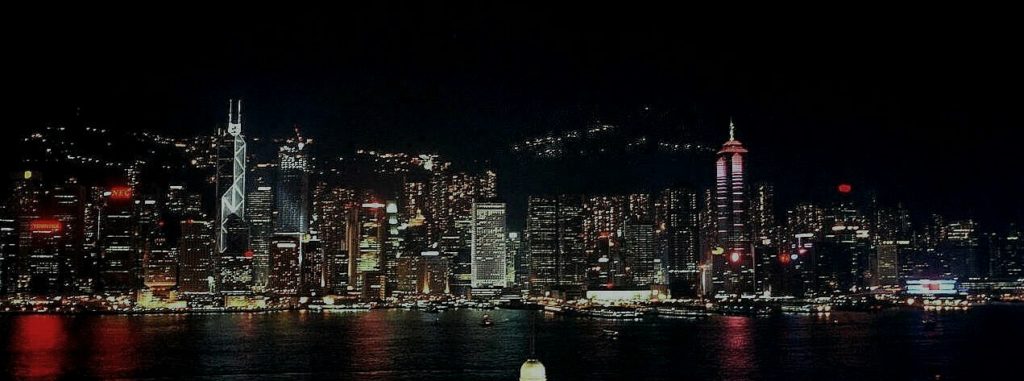
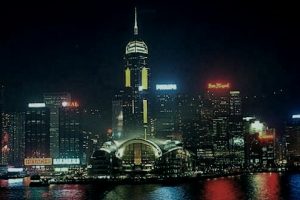
I welcome any questions or comments.
To contact me (Keith Stanley), please email me at kesta1001@yahoo.com.
Here are some links to others of my pages: